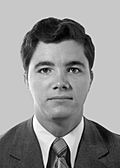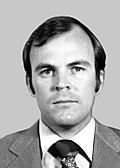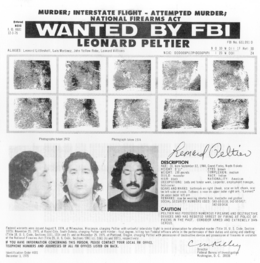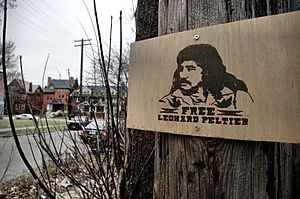Leonard Peltier facts for kids
Quick facts for kids
Leonard Peltier
|
|
|---|---|
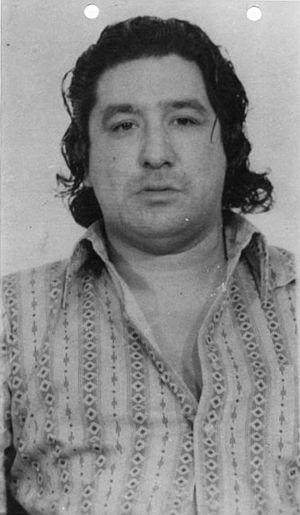
Peltier in 1972
|
|
| Born | September 12, 1944 Belcourt, North Dakota, U.S.
|
| Other names | Tate WiWikuwa, Gwarth-ee-lass |
| Movement | American Indian Movement |
| Children | 9 |
| Conviction(s) | First degree murder of a federal employee (18 U.S.C. §§ 1111 and 1114) (2 counts) |
| Criminal penalty | 2 consecutive life sentences; commuted to indefinite house arrest |
Leonard Peltier (born September 12, 1944) is a Native American activist. He was a member of the American Indian Movement (AIM). He was found guilty of killing two Federal Bureau of Investigation (FBI) agents. This happened during a shootout on June 26, 1975. The event took place on the Pine Ridge Indian Reservation in South Dakota.
Peltier was sentenced to two life terms in prison. He became eligible for parole in 1993. On January 19, 2025, President Joe Biden changed his sentence. Peltier was allowed to go under house arrest. He was released on February 18, 2025. He moved to the Turtle Mountain Indian Reservation in Belcourt, North Dakota.
In his 1999 book Prison Writings: My Life Is My Sun Dance, Peltier said he was part of the shootout. But he stated he did not kill the FBI agents. Many people, including human rights groups like Amnesty International, supported his release. Famous figures like Nelson Mandela and the 14th Dalai Lama also asked for his freedom.
At the time of the shootout, Peltier was active in AIM. This group worked for Indigenous rights. They fought against racism and police brutality faced by Native Americans.
Contents
Early Life and Education
Peltier was born on September 12, 1944. This was at the Turtle Mountain Indian Reservation in North Dakota. He is from the Lakota, Dakota, and Anishinaabe tribes. He grew up among the Turtle Mountain Chippewa and Fort Totten Sioux Nations. He was one of 13 children.
His parents divorced when he was four. Leonard and his sister lived with their grandparents. In 1953, he went to the Wahpeton Indian School. This was a boarding school run by the Bureau of Indian Affairs (BIA). The school tried to make Indigenous children adopt white American culture. They had to speak English and could not practice Native American culture.
He finished Wahpeton in 1957. Then he went to the Flandreau Indian School. After ninth grade, he returned home. He later earned his general equivalency degree (GED).
Career and Activism
In 1965, Peltier moved to Seattle, Washington. He worked as a welder and construction worker. He also co-owned an auto shop. The shop's upper floor was a safe place for Native Americans. It helped those dealing with addiction or leaving prison. This part of the business cost too much, so they closed it.
In Seattle, Peltier became involved in Native American civil rights. In the early 1970s, he learned about problems at the Pine Ridge Indian Reservation. There was tension between the tribal chairman and traditional Lakota members. Dennis Banks invited Peltier to join AIM. Peltier became an official member of the American Indian Movement (AIM) in 1972. AIM was started in 1968 to fight for civil rights.
The tribal chairman had a private group called the Guardians of the Oglala Nation (GOON). This group was known for attacking political opponents. Protests led to AIM and Lakota members taking over Wounded Knee in 1973. Federal forces surrounded them for 71 days. This was called the Wounded Knee Occupation. Peltier was in jail in Milwaukee during most of this time. He was charged with attempted murder in a different protest.
In 1975, Peltier went to Pine Ridge with AIM. He wanted to help reduce violence there. At this time, he was wanted for a charge in Milwaukee. He was later found not guilty of that charge in 1978. Peltier had seven children from two marriages and adopted two more.
Shootout at Pine Ridge
On June 26, 1975, FBI agents Ronald Arthur Williams and Jack Ross Coler were at Pine Ridge. They were looking for a young man. Around 11:50 a.m., the agents reported following a white and red Chevrolet Suburban Carryall. This vehicle reportedly carried Peltier and others.
The Suburban drove onto the Jumping Bull Ranch. AIM members were camping there. The people in the Suburban stopped and got out. A shootout began. Williams radioed that he and Coler were under fire. He said they had been shot. FBI Agent Gary Adams was the first to respond. But he and other officers also came under fire. They could not reach Coler and Williams in time. Both agents died within the first ten minutes.
Authorities found the agents' bodies around 4:25 p.m. The FBI stated that Norman Charles fired a rifle. Peltier fired an AR-15 rifle. The two agents had fired five shots in total. Their vehicles had 125 bullet holes. Many were from an AR-15 rifle. Coler was 28 and Williams was 27.
The FBI reported that Williams was shot in the hand, body, and foot. He then had a fatal shot to the head. Coler was shot twice in the head. Williams's car was driven into the AIM camp. The agents' guns were taken.
Aftermath
Three men were arrested for the shooting. They were Peltier, Robert Robideau, and Darrelle "Dino" Butler. All were AIM members at the Jumping Bull compound. Peltier gave different stories about what he was doing that morning. In his 1999 book, he said he was in the shootout but did not kill the agents.
On September 5, Butler was arrested. Agent Williams' handgun was found nearby. Days later, Peltier bought a station wagon. The next day, ammunition in Peltier's station wagon exploded by accident. Coler's rifle and an AR-15 were found in the burned vehicle. Peltier later fled from police in Oregon. His thumbprint and Coler's handgun were found in the vehicle he left behind.
Trial and Conviction
On December 22, 1975, Peltier was put on the FBI's Ten Most Wanted list. He was arrested in Canada on February 6, 1976. In December 1976, Peltier was sent from Canada to the United States. This was based on documents from the FBI. Canada's Solicitor General later said these documents had false information.
One document used for Peltier's extradition was from Myrtle Poor Bear. She said she was Peltier's girlfriend and saw the killings. But Peltier and others said she did not know him and was not there. Poor Bear later said the FBI made her lie. The judge did not allow her to testify against the FBI. However, the Canadian government later said the extradition was lawful. They found enough evidence to send him to trial.
Robideau and Butler were found not guilty. They argued self-defense. Forensic evidence showed they did not kill the agents. Peltier's trial was held in Fargo, North Dakota. The jury found him guilty of killing Coler and Williams. Unlike the other trial, the FBI showed evidence that the agents were shot at close range. This happened when they were already hurt. So, Peltier could not claim self-defense. The jury also saw photos of the agents and the crime scene. In April 1977, Peltier was found guilty. He was sentenced to two life sentences.
Some groups have questioned Peltier's guilt. They point to problems with the FBI's handling of the case. Two witnesses later said they lied under pressure from the FBI. One witness was given immunity for testifying against Peltier.
Kevin Sharp, Peltier's lawyer, spoke in June 2024. He said Pine Ridge was dangerous with violence. He stated that Peltier did not shoot the agents. He believes the FBI knew this and hid evidence. He also mentioned that the government now admits they do not know who killed the agents.
Evidence Questions
FBI radio messages first said agents were looking for a red pickup truck. The FBI confirmed this. But Peltier drove an orange and white Chevrolet Suburban. At Peltier's trial, FBI agents changed their story. They said they were looking for an orange and white van. This was a big point of disagreement.
The FBI said an AR-15 rifle killed the agents. Several AR-15s were in the area. The appeals court upheld Peltier's conviction in 1986. They noted that even if there were other AR-15s, the expert could not match all shell casings to Peltier's rifle. They said this was not important because those shells were found where no one could have shot the agents.
In 2004, a new look at the FBI ballistics report happened. An expert said some shell casings did not come from the rifle linked to Peltier. The appeals court again rejected this. They said this new information would not have changed the jury's decision.
1979 Prison Escape
Peltier started his sentences in 1977. On July 20, 1979, he and two other inmates escaped from prison. One inmate was shot and killed. Another was caught quickly. Peltier was free for three days. He was caught near Santa Maria, California. A farmer saw him with a rifle. Peltier had taken some crops, shoes, a wallet, and a truck key. He tried to drive away but the truck broke down. He was caught without a fight. Peltier was given more prison time for escaping and having a gun.
Clemency and Commutation
Support for Clemency
Peltier's conviction caused much debate. Many famous people criticized it. Peltier said on CNN in 1999 that he did not commit the murders. He also said he did not know who did. He has called himself a political prisoner. Many legal appeals were made for him. But the FBI always opposed them.
His requests for clemency got support from many civil rights leaders. These included Nelson Mandela, Archbishop Desmond Tutu, and Rev. Jesse Jackson. The 14th Dalai Lama and Mother Teresa also supported him. International groups like the Office of the United Nations High Commissioner for Human Rights and Amnesty International campaigned for his release. In the United States, groups like the Kennedy Memorial Center for Human Rights also supported him.
The police officer who arrested Peltier, Bob Newbrook, believes Peltier was "extradited illegally." He also thinks Peltier "didn't get a fair trial." In June 2022, the United Nations Human Rights Council said Peltier's detention was unfair. They asked for a "full and independent investigation." They urged the U.S. government to fix his situation.
Clemency Denial and Commutation
In 1999, Peltier asked for a review of his case. It was rejected in 2003. In 2001, there were rumors that President Bill Clinton might free Peltier. About 500 FBI agents protested this. FBI director Louis Freeh sent a letter against it. Clinton did not grant clemency. In 2009, President George W. Bush also denied Peltier's request.
In 2016, Peltier's lawyers asked President Barack Obama to commute his sentence. Pope Francis and James H. Reynolds supported this. Reynolds was a lawyer who worked on Peltier's case. He wrote that clemency was "in the best interest of justice." He also said the case against Peltier was "very thin." Obama denied the request in 2017. Peltier also asked President Trump for clemency.
On July 9, 2021, Reynolds wrote to President Biden. He stated, "We were not able to prove that Mr. Peltier personally committed any offense." On February 6, 2023, Peltier again asked for clemency.
On June 10, 2024, Peltier had his first parole hearing since 2009. His lawyer said it was likely his "last chance." On July 2, 2024, he was denied parole. Another hearing was set for 2026. From 2014 until 2025, Peltier was held at a high-security prison in Florida.
Presidential Commutation and Release
On January 19, 2025, President Joe Biden changed Peltier's life sentence. He was allowed to go under home confinement starting February 18, 2025. Peltier was released on that date. His son said the Turtle Mountain Band had a home ready for him. Peltier's sister confirmed he went to the Turtle Mountain Indian Reservation. He could reunite with his family there. On February 19, 2025, Peltier spoke publicly at an event welcoming him home.
Health Issues
Over the years in prison, Peltier's health got worse. By 2016, his diabetes caused vision and kidney problems. In April 2024, groups asked for his parole. They noted his declining health. He was almost 80 years old. He had kidney disease, diabetes, and was nearly blind. He also had an untreated aortic aneurysm. He needed a wheelchair.
COVID-19 made Peltier weaker. His allies asked for his release or transfer to a prison closer to his family. They said the prison was not giving him proper medical care. They claimed this was "cruel and unusual punishment." They said he was not getting a healthy diet or insulin. He also could not use his CPAP machine for sleep apnea. When his sentence was changed in January 2025, his sister said he now uses a walker.
Prison Writings: My Life Is My Sun Dance
Peltier wrote a memoir called My Life Is My Sun Dance.
Introduction and Preface
Chief Arvol Looking Horse and former Attorney Clark Ramsey Clark wrote the introduction and preface. Chief Looking Horse is a spiritual leader. Clark has helped Peltier with his appeals.
Chief Looking Horse talks about Peltier's suffering. He says Peltier offered himself for his people's peace. He also calls for Peltier's freedom. Clark says Peltier's struggle is about human rights. He argues for Peltier's innocence at Pine Ridge. Both leaders ask for Peltier's release.
Part 1: In My Own Voice
Leonard Peltier starts his book by describing his difficult prison conditions. He thanks his readers. He says he is writing to live, not to die. He reclaims his identity. He uses his names, Leonard Peltier and Gwarth-ee-lass. He wants readers to see him as a person.
Peltier sees his struggle as his people's struggle. He finds strength in this. He shares wisdom from elders. They taught him that speaking out against injustice is a duty. He describes the Sun Dance. This is a spiritual ceremony. It helps him resist his oppressors.
Part 2: Who I Am
Peltier talks about being Indigenous in North America. He says his story is his people's story. He describes a history of sadness and injustice. He explains how Indigenous lands were taken. People were forced onto reservations. He mentions the Wounded Knee Massacre in 1890. He says this was part of a genocide.
He points out that poverty and other problems are high on reservations today. He highlights the American Indian Movement. AIM tried to show the world the wrongs against Indigenous people. This part also has a poem. It is called "an eagle's cry." It is about wanting to be heard.
Part 3: Growing Up Indian
Peltier writes about the importance of names. Names give people a sense of who they are. They show what a person can become. He explains his names. Tate Wikuw means "Wind Chases the Sun." Gwarth-ee-lass means "He Leads the People."
He talks about the struggles of Indigenous people. Their land and identities are under attack. He highlights how Indigenous people face racial profiling. He says the prison system targets them. He shows how colonization affects Indigenous people in prisons.
Part 4: Becoming Political
Peltier writes about joining Indigenous movements. He saw Native Americans being hurt for protecting their rights. These rights are guaranteed by treaties. But the U.S. government did not uphold them. So, he started fighting for civil and Indigenous rights with AIM.
He says the U.S. government wanted Indigenous land. They used violence and wrongful arrests. As an AIM member, he took part in the Bureau of Indian Affairs (BIA) takeover in 1972. This started as a peace march. He also helped Indigenous people find work. He worked in an alcohol rehab program.
In 1975, Peltier went to the Oglala nation. He helped protect the people there. He and other AIM members were sent to defend residents. They were not a military group. But they were attacked. They had to defend themselves with few weapons. Peltier believes the government hid information. He says they lied to blame him and AIM.
Part 5: That Day at Oglala
This section is Peltier's story of the attack at Oglala. This led to his arrest. Peltier was staying in a "tent city" with other AIM members. The Lakota Elders asked for their protection. They needed protection from the GOON squads. These squads had been "terrorizing" the Pine Ridge Reservation.
On June 26, 1975, their group was attacked. The group included women, children, and elders. They were attacked by "lawmen, GOONs, SWAT teams, vigilantes, BIA police." Peltier's group did not want to fight back right away. But two FBI agents, Jack R. Coler and Ronald A. Williams, were killed. The violence against Peltier's group grew.
Peltier denies killing the two FBI agents. He says he would have stopped the real attacker. Peltier and his group escaped the attack. Everyone survived except Joe Killsright Stuntz. While running, the group stopped to pray. Peltier says an eagle led them to safety. He thanks those who helped them.
While Peltier's group hid, police searched for them. They terrorized the Pine Ridge Reservation. Elders in Peltier's group decided to hide until the Sun Dance. They wanted to thank Wakan Tanka for saving them. But police caught members of the group. Peltier decided to flee to Canada. He hoped for safety there. He did not trust the American government to give him a fair trial.
Part 6: A Life in Hell
Peltier describes his arrest in Canada on February 6, 1976. He says the FBI forced Myrtle Poor Bear to give false statements. She claimed she saw the killings and was his ex-girlfriend. Peltier says he was treated unfairly. But he refuses to be a victim. He sees himself as a warrior. He finds strength in the Sun Dance.
Peltier says he was promised a fair trial. He signed papers to return to the U.S. He received two life sentences on June 1, 1977. He was sent to prison. He believes the FBI used fake evidence. They needed someone to blame for the agents' deaths. Peltier describes unfair treatment in prison. He survived an assassination plot. He also escaped during a prison transfer in 1979.
Peltier talks about a dream he had in solitary confinement. He shares it as a story called "The Last Battle." He also describes the "inipi, or sweat-lodge ceremony." He did this every Saturday in prison. It made him feel "blessed freedom" despite being locked up.
Part 7: A Message to Humanity
In the last part of his book, Peltier shares his vision for humanity's future. He says everyone needs to show respect, kindness, and work together. He encourages celebrating differences. He believes in finding strength in being together. He finds hope in children. He hopes for a "Great Healing" for a better future.
To make this vision real, Peltier says we need to make a real effort. He writes about how important individual actions are. He also stresses the need for Indigenous sovereignty.
Images for kids
-
FBI affidavit of Norman Patrick Brown
See also
 In Spanish: Leonard Peltier para niños
In Spanish: Leonard Peltier para niños


